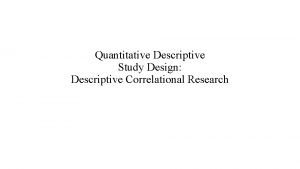Quantitative Research 14 Lisa Harrison Chapter 2 Quantitative












- Slides: 12

Quantitative Research (14) Lisa Harrison: Chapter 2

Quantitative Research (14) Quantitative Research refers to the use of measurement in the analysis of behavior and attitudes. Positivist School Est. in 19 th C. Represented a desire to create a “science of society. ” Social Scientists wanted to understand thus learn how to control the social world. Marx and Engels are prominent examples of this. …

Types of Data (17) Manageable Parts Statistics can be broken down into manageable parts. Statistical analysis operates at different levels, and the level can influence how detailed or informative the data is. …

Three levels of statistical analysis (17) Nominal: Mutually Exclusive Data Most basic level: Refers to discrete or mutually exclusive categories: age, party affiliation, voter, non-voter. Individuals can only fit into one category at a time. Ordinal: Ranked Data Next level of analysis: ranked data. It enables us to able to “rank” cases in relation to each other. It is data that can be placed in comparative order: which candidate received the most votes? Interval/Ratio (18) Allows use to measure how far apart measurements are. It has a zero point so it is effective at measuring change.

The Nature of Social Science Research Levels of Measurement: Limitations Nominal: cannot indicate grade, ranking, a quality scale (better or worse), higher or lower, more or less. It is simply a label. Ordinal Data: provides a ranking, but not a magnitude of difference between numbers, or points on a scale. Intervals between points on a scale are not known: Teeth Cleaning -------Filling----Root Canal 1 2 3 4 5 Difference?

The Nature of Social Science Research Levels of Measurement: Strengths Interval-Ratio: Allows you to indicate the order of categories, but also the exact differences between them. Uses constant units of measurement with equal intervals between them. Temperature: 80 ------90 ------100 Difference?

The Nature of Social Science Research Levels of Measurement: Strengths Difference between Interval-Ratio: Interval: artificial zero point: Zero Degrees: cold, but a temperature. Ratio: absolute or true zero point: Zero Money: No Money in the Bank. Interval-Ratio: Can Be Natural or Invented. Some variables in their natural form are interval level (weight, number of siblings you have, hours you watch TV per day). Others become interval because we scale them.

Analytical Terms Populations: Population is a group that shares characteristics to which we apply an explanation. Examples: Civil Servants Party members (Republicans/Democrats/Greens) The Unemployed Samples: We can rarely study an entire population, even a small one like Suffolk University undergraduates. So we have to rely on making generalizations based on a sample.

Types of Sampling (20 -21) Probabilistic Sampling (Random): Types: Random, systematic, stratified, cluster Random (most common): everyone has a equal and independent chance of being selected. Challenges: Telephone sampling Not everyone has a phone Not everyone is listed Busy street Not random: Not typical of the population.

Types of Sampling (20 -21) Non-Probabilistic Sampling (Non Random) Select a specific population to study – those aged between 18 -25, women, and read the newspaper. …

Sample Size Calculations Confidence Interval: It “is the plus-or minus figure usually reported in newspaper or television opinion poll results. For example, if you use a confidence interval of 4 and 47% percent of your sample picks an answer you can be "sure" that if you had asked the question of the entire relevant population between 43% (47 -4) and 51% (47+4) would have picked that answer. ” Confidence level: It “tells you how sure you can be. It is expressed as a percentage and represents how often the true percentage of the population who would pick an answer lies within the confidence interval. The 95% confidence level means you can be 95% certain; the 99% confidence level means you can be 99% certain. Most researchers use the 95% confidence level. ” Source: http: //www. surveysystem. com/sscalc. htm#cineeded

Sample Size Calculations 95 % Confidence Level: CI: 4 Pop: 2500 Pop: 25, 000 Pop: 250, 000 Sample: 484 Sample: 586 Sample: 599 Sample Size Calculator
 Meaning of harrison bergeron
Meaning of harrison bergeron Parts of chapter 3 research methodology
Parts of chapter 3 research methodology Chapter 2 quantitative research
Chapter 2 quantitative research Qualitative analysis
Qualitative analysis Kind of quantitative research
Kind of quantitative research Sampling methods in qualitative and quantitative research
Sampling methods in qualitative and quantitative research Appendices research example
Appendices research example Quantitative descriptive method
Quantitative descriptive method What is descriptive research design
What is descriptive research design Which of the following is an example of quantitative
Which of the following is an example of quantitative Descriptive correlational research design qualitative
Descriptive correlational research design qualitative Findings of qualitative research
Findings of qualitative research Research design descriptive quantitative
Research design descriptive quantitative






















